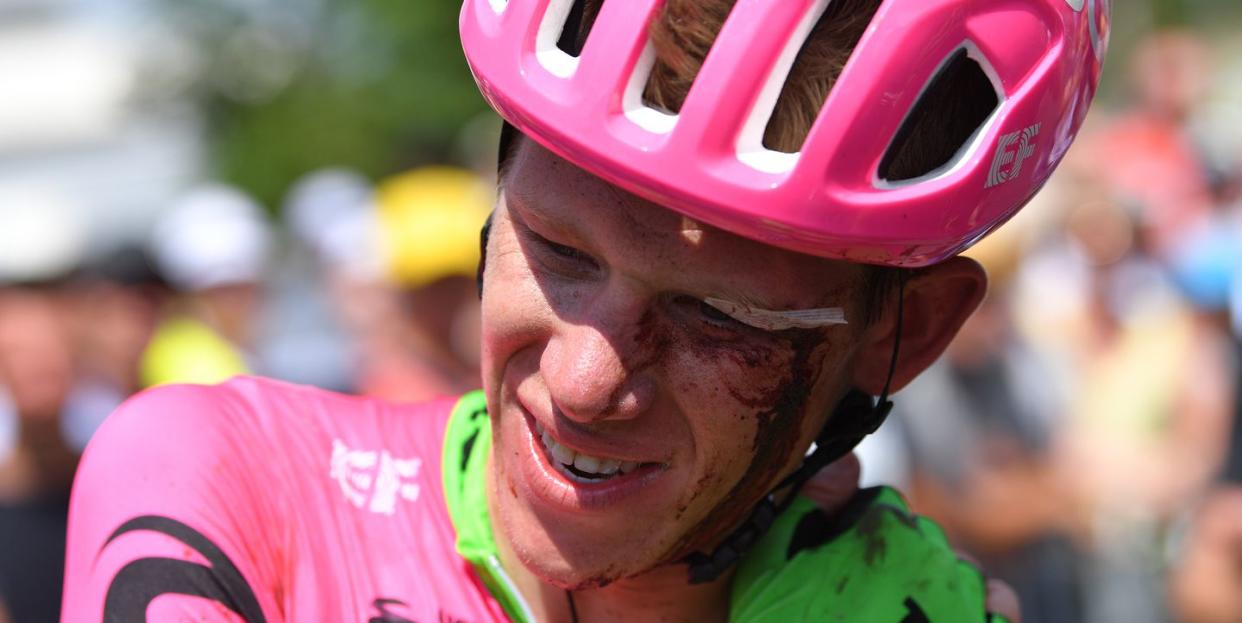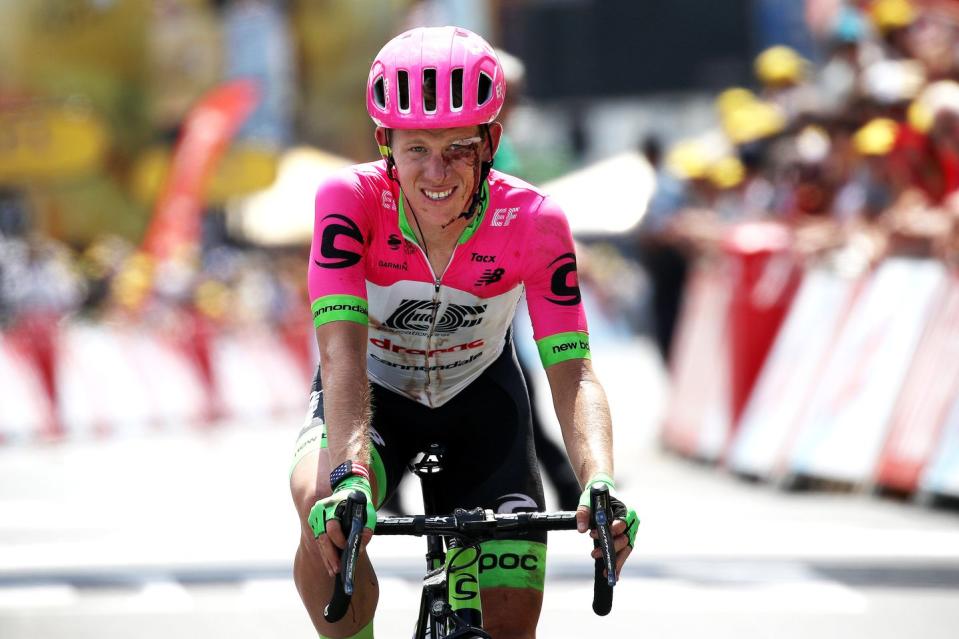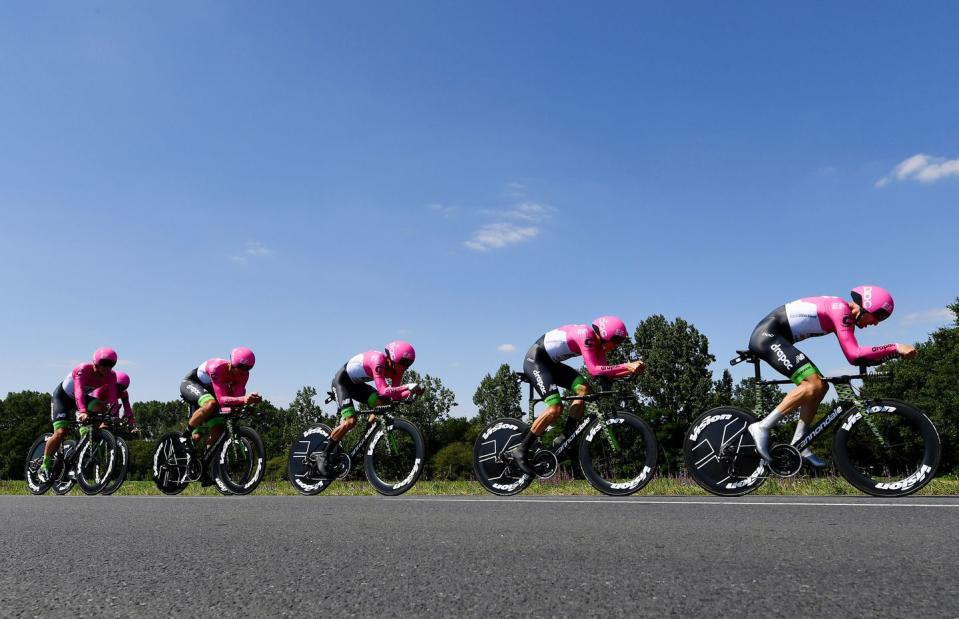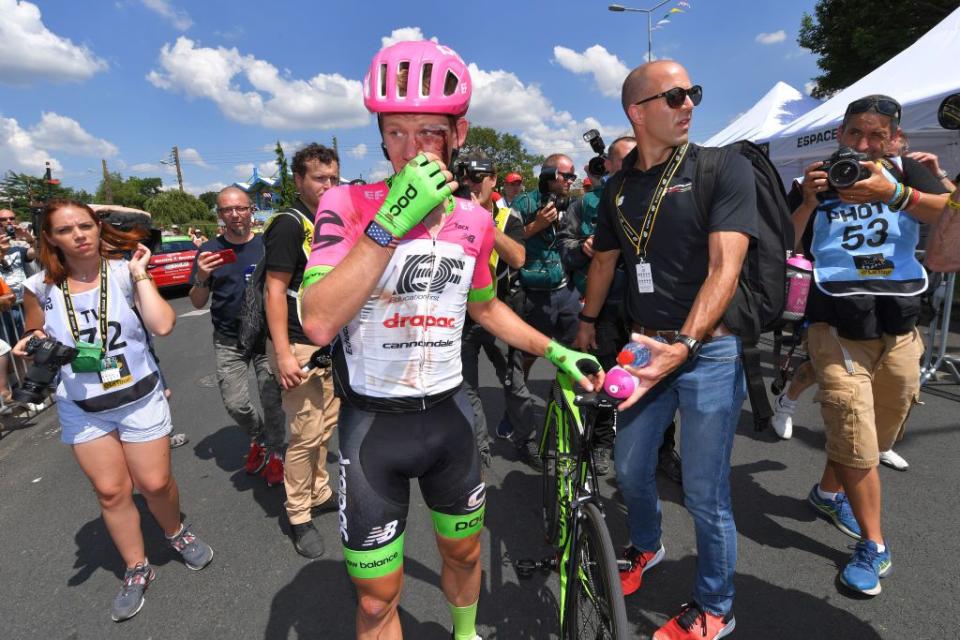Lawson Craddock Will Take the Tour de France’s Most Peculiar Honor: Last Place

When Lawson Craddock rolls across the finish line of the 2018 Tour de France on Sunday, he’ll join an exclusive club of pro cyclists who have earned one of the sport’s most endearing distinctions: finishing last.
Craddock, a Texan on the EF Education First team, currently sits 145th overall in the General Classification, 4.5 hours down to presumptive winner Geraint Thomas. For 21 stages, he’s held the informal title of lanterne rouge, the race’s last-placed rider on overall time. He’ll be the first American to finish last overall.
It’s not an achievement he wanted when the race started on July 7. Craddock’s job was to support team leader Rigoberto Uran, second overall last year, particularly in the crucial team time trial early in the first week. But those plans quickly came apart in the Stage 1 feed zone, when an errant water bottle took out Craddock’s front wheel and sent him crashing down hard with a broken shoulder. He finished dead last on the day, grimacing through sweat, blood dripping from a gash on his left eyebrow. But he finished.
And every day since then, at first heavily bandaged and unable to even stand up on the bike, he finished. On Stage 3, the team time trial, he even put in a few pulls and did the work he had been brought to do. He survived the crucible of Stage 9’s jarring cobblestones, which saw Uran crash and eventually drop out three days later from lingering injuries. But Craddock kept fighting, and finishing.
“After the first week, once we hit the mountains, doing those 20K climbs where you have to climb out of the saddle took a lot out of me,” he told Bicycling after Stage 20. “It was a challenge each and every day to make it to the finish.”
That’s the spirit of the lanterne rouge. Craddock may be 145th, but 176 riders started the Tour. Just by finishing, he’s outlasted 31 who crashed out, dropped out, or were time cut.

Lanterne rouge is named for the red lantern that train conductors once hung from the last car. It has never been an official classification-there’s no jersey or a special-color number, no podium ceremony-and the Tour’s organization has largely ignored it and twice even tried to stamp it out. But among fans, and some riders, it’s an honor.
The first last-place rider was Arsène Milocheau, who finished 21st in the inaugural Tour in 1903. Max Leonard, a British writer and author of Lanterne Rouge: The Last Man in the Tour de France, said the earliest mention he can find of the term in newspaper archives is 1919. But he suspects it began earlier, before World War I forced the race’s temporary suspension.
It took hold, Leonard thinks, because of how it represents fighting spirit. “People always like an underdog,” he said. “It’s the idea that this guy has been forgotten and that we should reward his persistence and determination and courage.”
While it’s easy to deride a last-place rider as an also-ran, that’s often inaccurate. “Lanterne rouges have been Paris-Roubaix winners and Olympic and national champions,” Leonard said. For example, Classics star and two-time Tour of Flanders winner Edwig van Hooydonck was lanterne rouge in 1993.
Sometimes, it’s a rider who does massive pacemaking work for his team early in the race, before TV coverage begins, and is saving his strength to do the same the next day. Or it’s an injured rider or sprinter, fighting to simply get over the mountains, like Sam Bennett in 2016 or Jimmy Casper (twice).
Repeat “winners” are rare. The record is three straight, by Wim Vansevenant (2006-2008). And riders don’t typically seek out the honor, but for some it has prestige. For decades, pro cyclists were badly paid, but if they were popular, they could make money through appearance fees at post-Tour criteriums, pure entertainment events where the results were fixed. “If you were lanterne rouge, you’d get the criterium invites because you were such a favorite with the fans,” Leonard said. Riders could make three times their annual salary from just a few events.
“In 1979, Gerhard Schonbacher, a sprinter, was lanterne rouge and realized that it was this amazing publicity thing,” Leonard said. Schonbacher had a rival: Philippe Tesnière, 1978’s lanterne rouge. In the final time trial, both slow-pedaled intentionally to lose time. But Tesnière took it too far and missed the time cut.

The following year, Tour organizers, upset that the classification was gaining notoriety, reinstated an old elimination rule from the 1940s where, from Stage 14 on, the last-placed rider in the GC each day would get cut. Schonbacher ably managed to stay just out of last place until the final stage.
Craddock didn’t face any such rules, but he was still concerned on several days about time: in the mountain stages after the rest days, and the short, 65K Stage 17 in the Pyrenees where, he said, he actually had one of his better days this Tour.
Since its heyday in the ’70s, lanterne rouge has slowly retreated from public consciousness. Leonard suspects that economics and television play roles. Today, the sport’s top level has a minimum salary, and TV coverage has reduced the post-Tour criterium circuit as a means of marketing and showcasing the sport.
“Honestly, [lanterne rouge] doesn’t mean that much to me,” Craddock said. “It never became a goal. My goal was to do whatever I could to help the team and make it to the finish. It didn’t matter if I was 50th or 150th.”
But its meaning still resonates with some. In 2008, Vansevenant’s last year as lanterne rouge, he was so intent on beating Bernhard Eisel for the honor that he stopped mid-lap on the Champs-Elysées to ensure Eisel wouldn’t finish behind him.
Craddock, however, will break ground in two ways. First, Leonard said, it might be the first time that a single rider has been lanterne rouge for the entire Tour. Second, like those riders who hoped to capitalize on their fame, Craddock is making a pile of money off his daily finishes.

Only it’s not for him: After his Stage 1 crash, Craddock decided to donate $100 for each stage he finished to Alkek Velodrome in Houston. It’s where he first started racing, at 10 years old, and it was damaged in the flooding from Hurricane Maria. Craddock invited fans to match him, and his dad set up a GoFundMe with a $1,000 target. It quickly gained notice and donations, blowing through that goal within a day.
The campaign got coverage in ESPN, Sports Illustrated, the New York Times, and other media outlets. As of the finish of Stage 20, it had raised more than $150,000.
“Without that fundraiser, I probably would’ve gone home a couple of weeks ago,” Craddock said. “Especially in the days immediately after the crash and in that recovery process, I drew a lot of motivation from the campaign. It’s going to change the future of the track.”
But tomorrow, crossing the finish line on the Champs-Elysées, Craddock will reflect on his own journey and achievement. “Just the fact that I was able to make it is a pretty great thing,” he said. “I’ll definitely be pretty emotional crossing the finish line.”
('You Might Also Like',)